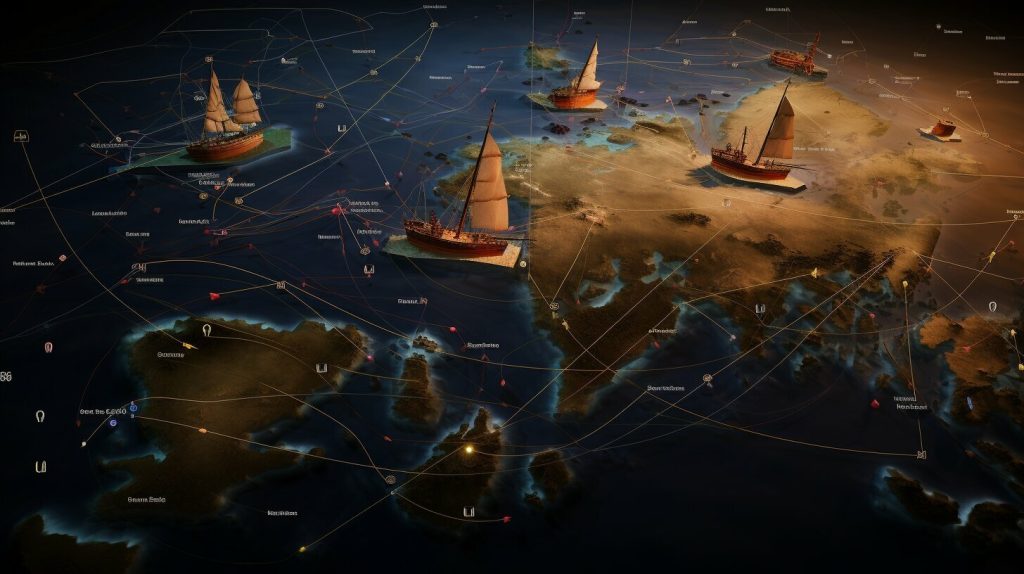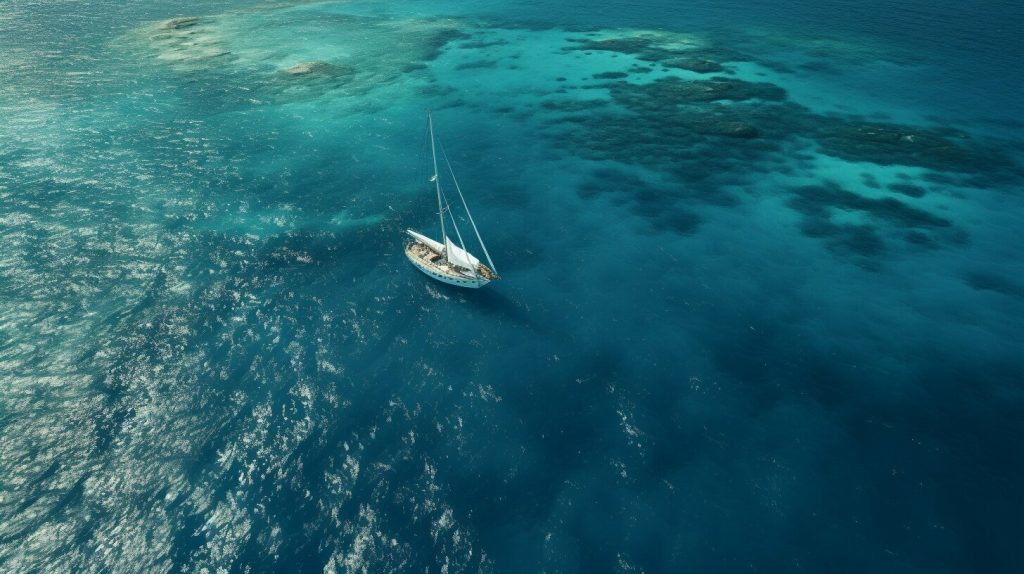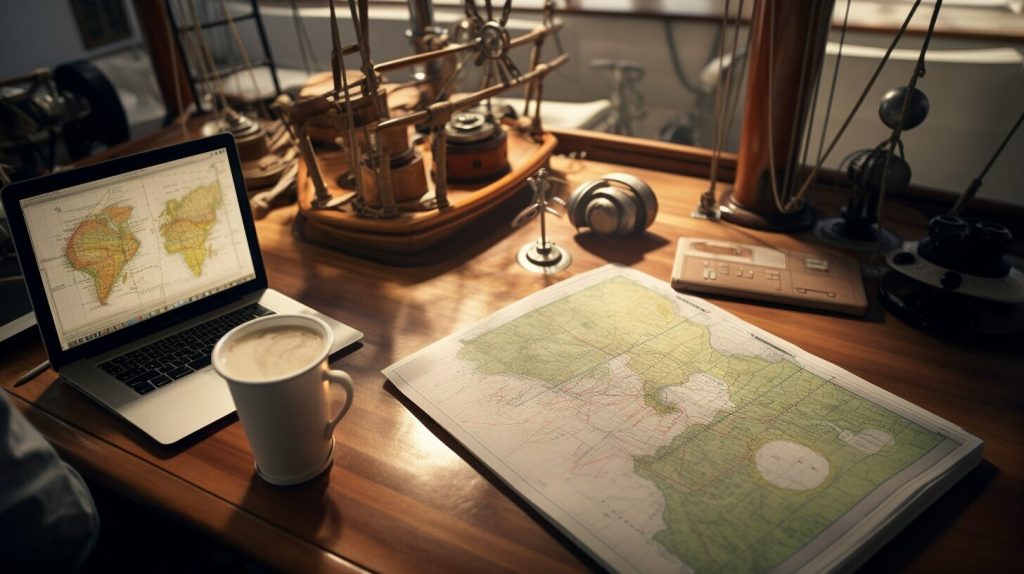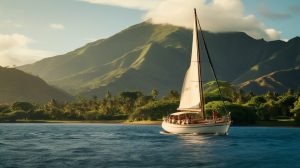Planning a sailing route is an essential skill for any aspiring sailor, as it ensures a safe and successful voyage across the seas. Whether you’re embarking on a leisurely journey or a professional expedition, a well-thought-out route is crucial for navigating the waters and reaching your destination smoothly.
In this guide, I will take you through the process of planning a sailing route, from the initial appraisal stage to execution and monitoring. We will explore the factors to consider, potential challenges, and the resources available to enhance your planning. By the end of this article, you’ll have a solid understanding of how to master the seas and chart your path to adventure.
Key Takeaways:
- Planning a sailing route is essential for a safe and successful voyage.
- The appraisal stage involves gathering information and evaluating different routes.
- The planning stage includes creating detailed routes and contingency plans.
- Execution requires real-time adjustments based on changing conditions.
- Monitoring ensures the safety and compliance of the sailing route.
The Appraisal Stage: Gathering Information and Evaluating Routes
Before setting sail, it’s crucial to gather all the necessary information and evaluate different routes to ensure a well-informed sailing plan. The appraisal stage of sailing route planning is where the master of the ship and the chief navigating officer carefully gather all relevant information about the passage and consider various factors to determine the best route.
This stage involves a thorough evaluation of charts, ocean passages, routing charts, tide tables, navigational warnings, and personal experience. By analyzing these resources, the navigating officers can assess potential hazards, identify safe routes, and make informed decisions about the journey’s course.
During the appraisal stage, data gathering tools such as GPS devices, weather forecasting services, and digital navigation charts play an integral role in providing accurate and up-to-date information. By leveraging the power of technology, the appraisal stage becomes more efficient, enabling the crew to gather and process information more effectively.
While evaluating routes, several factors must be taken into account. These include navigational challenges, weather conditions, shipping schedules, and vessel capabilities. It’s essential to assess potential risks, such as rough seas, shallow waters, or areas with heavy traffic. By evaluating these factors, the navigating officers can identify the most efficient and safe route for the journey.
The Planning Stage: Detailed Routes and Contingency Planning
Once the initial route has been appraised, it’s time to prepare a detailed plan that covers all aspects of the voyage, from potential risks to emergency protocols. This planning stage is crucial in ensuring a safe and successful sailing journey. The Officer of the Watch (OOW) takes charge of creating a comprehensive plan that accounts for various factors, including detailed routes, contingency planning, and safety measures.
Creating Detailed Routes
During the planning stage, the OOW uses charts, routing charts, and other navigational tools to define specific routes that the ship will follow. These routes take into consideration factors such as potential hazards like wrecks or reefs, shallow waters, and no-go areas. By carefully charting these details, the OOW ensures that the ship avoids any dangers along the way.
To enhance safety, margins of safety are also incorporated into the plan. These margins provide an extra buffer zone to account for unexpected circumstances or changes in weather conditions. Additionally, course alterations are considered, allowing the crew to adjust their route in real-time if necessary.
Contingency Planning
Contingency planning is an essential part of the overall sailing route plan. This involves identifying potential risks and developing strategies to mitigate them. The OOW considers factors like adverse weather conditions, technical failures, and medical emergencies when crafting contingency plans.
For example, if a storm is forecasted along the planned route, the contingency plan may include alternative routes or safe haven options for the ship to seek shelter. Emergency stopping points are also identified, allowing the crew to quickly react in case of unforeseen circumstances.
Ensuring Safety and Efficiency
By creating detailed routes and contingency plans, the planning stage sets the foundation for a safe and efficient sailing journey. It provides a roadmap for the crew, ensuring they are well-prepared to handle any challenges that may arise. The plan serves as a valuable reference throughout the voyage and allows for effective decision-making.
Table: Contingency Planning Checklist
| Contingency | Action |
|---|---|
| Adverse Weather | Identify alternative routes or safe havens to avoid severe weather conditions. |
| Technical Failure | Develop protocols to address potential equipment failures and establish backup systems. |
| Medical Emergency | Ensure crew members are trained in first aid and establish communication protocols with medical support. |
| Unforeseen Circumstances | Prepare for unexpected events and establish procedures to handle them effectively. |
As the ship sets sail, the detailed routes and contingency plans provide a sense of security and peace of mind to the crew. They can navigate confidently, knowing that they have thoroughly planned for any potential challenges that may come their way.
Remember, the planning stage is just one part of the overall sailing route process. It is followed by the execution stage, where the voyage begins, and the monitoring stage, where the ship’s position is regularly checked to ensure safety and course compliance. By following a comprehensive approach to sailing route planning, mariners can master the seas and embark on successful sailing journeys.
With the plan in hand, it’s time to embark on the journey and make necessary adjustments along the way to ensure a smooth and safe voyage. The execution stage of sailing route planning is crucial, as it requires the navigating officers to navigate real-time adjustments based on changing atmospheric and oceanographic conditions. This requires adaptability, quick thinking, and effective communication among the crew.
Navigating in real-time requires constant monitoring of the ship’s position and making adjustments to the speed and route as needed. The officers must stay vigilant and keep an eye out for any unexpected hazards or changes in weather conditions. It is essential to rely on navigational aids like charts, GPS, and weather forecasting services to make informed decisions and avoid potential dangers.
During the execution stage, the navigating officers must also consider factors like traffic separation schemes, marine protected areas, and restricted zones. These areas may require alterations to the planned route to ensure compliance with regulations. The officers must stay updated on any navigational warnings or notices to mariners that may affect the voyage.
Throughout the execution stage, effective communication between the navigating officers, crew, and other vessels is vital. This helps to coordinate movements, exchange important information, and ensure the safety of all involved. The officers must also stay in constant contact with the vessel’s shore-side support, providing updates on the progress of the voyage and any adjustments made.
In summary, the execution stage of sailing route planning involves navigating real-time adjustments to ensure a smooth and safe voyage. It requires adaptability, quick thinking, and effective communication. By staying vigilant, relying on navigational aids, and complying with regulations, the navigating officers can successfully navigate the challenges of the journey while keeping the ship and crew safe.
Example Table for Real-Time Adjustments:
| Adjustment | Description |
|---|---|
| Speed | Adjusting the speed of the vessel to account for changing weather conditions or to meet specific arrival times. |
| Course Alterations | Making changes to the planned route due to hazards, navigational warnings, or regulatory requirements. |
| Evasive Actions | Taking evasive actions to avoid collisions with other vessels or navigational hazards. |
| Emergency Modifications | Making immediate route changes in case of emergencies like engine failures, severe weather, or medical emergencies. |
With these real-time adjustments, the navigating officers can navigate the challenges of the voyage while keeping the ship and crew safe. Remember, the execution stage of sailing route planning requires constant monitoring, adaptability, and effective communication to ensure a successful journey.
As the voyage progresses, diligent monitoring is essential to guarantee the ship’s safety and compliance with the planned route. It is crucial for the navigating officers to stay vigilant and regularly check the ship’s position to ensure it remains on course and away from any potential danger areas. This ongoing monitoring allows for timely adjustments to be made if necessary, avoiding hazards and ensuring the safety of the crew and cargo.
One of the key aspects of monitoring is ensuring course compliance. This involves comparing the actual position of the ship with the planned route and making any necessary course alterations to maintain the intended path. By closely monitoring the ship’s position through various navigational techniques, such as using GPS and electronic charts, the crew can ensure that they stay within designated shipping lanes and avoid obstacles like reefs, wrecks, or shallow waters.
To aid in monitoring, navigational officers rely on tools such as navigational charts, tide tables, weather forecasts, and navigational warnings. These resources provide valuable information about current conditions and potential hazards that may arise during the voyage. By regularly consulting these resources and updating the ship’s course accordingly, the crew can navigate safely and efficiently.
Table: Essential Monitoring Activities
| Monitoring Activity | Description |
|---|---|
| Regular Position Checks | Checking the ship’s position at regular intervals to ensure it remains on the planned route. |
| Course Alterations | Making necessary adjustments to the ship’s course based on current conditions and potential hazards. |
| Consulting Navigational Resources | Referring to navigational charts, tide tables, weather forecasts, and navigational warnings to stay informed about current conditions and potential hazards. |
In conclusion, monitoring plays a vital role in ensuring the safety and course compliance of a sailing voyage. By diligently checking the ship’s position, making necessary course alterations, and consulting navigational resources, the crew can navigate safely and avoid potential dangers. With proper monitoring, a sailing journey can proceed smoothly and efficiently, ensuring the successful completion of the planned route.
Planning a sailing route involves taking into account multiple factors that can impact the success and efficiency of the voyage. It requires careful consideration of various elements to ensure a safe and smooth journey. From weather conditions to shipping deadlines, here are some key factors to consider when planning your sailing route.
1. Weather Conditions
One of the most critical factors in sailing route planning is the weather. Monitoring weather forecasts and understanding how wind patterns, storms, and currents may affect your journey is essential. By selecting the optimal time and route based on weather conditions, you can avoid rough seas and hazardous weather, ensuring a more comfortable and safe voyage.
2. Shipping Deadlines
If you are sailing for commercial purposes, it’s crucial to consider shipping deadlines when planning your route. Timely delivery of goods is essential for business operations, and missing a deadline can have significant financial implications. Mapping out your route to ensure you reach your destination on time is vital for successful sailing route planning.
3. Cargo and Crew Safety
The safety of your cargo and crew should be a top priority when planning a sailing route. Consider the nature of the cargo you are carrying and any special requirements or restrictions it may have. Additionally, assess the experience and capabilities of your crew, ensuring they have the necessary training and equipment to handle the journey’s challenges.
4. Fuel Costs
Fuel costs can significantly impact the overall cost of your sailing journey. When planning your route, consider the availability and prices of fuel along the way. Optimizing your route to minimize fuel consumption can help reduce costs and make your voyage more economically viable.
| Factors to Consider | Importance |
|---|---|
| Weather Conditions | High |
| Shipping Deadlines | High |
| Cargo and Crew Safety | High |
| Fuel Costs | Medium |
Planning a sailing route requires careful consideration of various factors to ensure a successful and safe journey. By factoring in weather conditions, shipping deadlines, cargo and crew safety, and fuel costs, you can create a well-optimized route that maximizes efficiency and minimizes risks. Remember, proper planning is key to mastering the seas and enjoying a smooth sailing experience.
Passage planning is not just a suggestion; it is a legal requirement that ensures the utmost safety and efficiency during a sailing voyage. As a master of the seas, I understand the significance of meticulously planning out every aspect of the journey. By conducting thorough passage planning, we can minimize risks, avoid potential dangers, and optimize our course to reach our destination safely and on time.
During the appraisal stage, I gather all relevant information about the passage, including charts, ocean passages, routing charts, tide tables, and navigational warnings. I also combine this data with my personal experience to evaluate different routes. This careful analysis helps me establish an initial route that takes into account factors like hazards, potential obstacles, and emergency stopping points.
Once the initial route is determined, the planning stage begins. As the Officer of the Watch (OOW), I prepare a more detailed plan that includes areas such as wrecks, reefs, shallow water, and emergency stopping points. I analyze factors like no-go areas, margins of safety, course alterations, tides and currents, and contingency planning. This meticulous planning ensures that I am fully equipped to handle any unforeseen circumstances that may arise during the journey.
| Appraisal Stage: | Gathering relevant information | Evaluating different routes |
|---|---|---|
| Planning Stage: | Preparing a detailed plan | Including potential hazards and safety measures |
| Execution Stage: | Navigating in real-time | Adjusting speed and route based on changing conditions |
| Monitoring: | Regularly checking ship’s position | Making necessary course alterations |
Creating a Safe Passage
During execution, I put the plan into action and make real-time adjustments based on changing atmospheric and oceanographic conditions. This flexibility ensures that I am always on the lookout for the safest and most efficient route. Regular monitoring of the ship’s position helps me stay clear of danger areas and make any necessary course alterations to maintain the safety of the vessel and the well-being of the crew.
Passage planning encompasses various factors that must be carefully considered. Shipping deadlines, weather forecasts, cargo and crew safety, fuel costs, and route optimization all play a vital role in ensuring a successful journey. By leveraging technology, such as GPS, weather forecasting services, and digital navigation charts, I can enhance the planning process and make more informed decisions to guarantee a smooth sailing experience.
In conclusion, passage planning is not an option but a mandatory process that guarantees safety and efficiency on the high seas. As a master of the seas, I take great pride in the comprehensive planning and attention to detail that goes into mapping out a sailing route. By prioritizing passage planning, I am able to navigate the challenges of the open waters with confidence and ensure a successful voyage.
Challenges and Potential Errors in Sailing Route Planning
While planning a sailing route, it’s crucial to be aware of the challenges and potential errors that can occur to ensure a smooth journey. Navigating the seas involves numerous factors that can impact the safety and efficiency of the voyage. Let’s explore some of the common challenges and potential errors that sailors may encounter during the route planning process.
Unpredictable Weather Conditions
One of the biggest challenges in sailing route planning is dealing with unpredictable weather conditions. Storms, high winds, and rough seas can significantly affect the safety and speed of the journey. It is essential to closely monitor weather forecasts and make necessary adjustments to the route to avoid dangerous conditions. Failure to accurately assess and adapt to changing weather patterns can lead to delays, damage to the vessel, or even endanger the crew’s lives.
Inaccurate Chart Data
Another potential error in sailing route planning is relying on inaccurate or outdated chart data. Charts provide crucial information about the depth of water, underwater hazards, and navigational aids. Using incorrect chart data can result in grounding or colliding with underwater obstacles, such as reefs or wrecks. To mitigate this risk, it’s crucial to ensure that the charts used are up-to-date and accurate, and to cross-reference information from multiple reliable sources.
Human Error and Lack of Experience
Human error and lack of experience during the planning stage can also lead to potential errors in sailing route planning. Failing to consider all relevant factors, misinterpreting navigational information, or overlooking potential risks can have serious consequences. It is essential for the navigating officers to have comprehensive knowledge of navigation techniques, as well as practical experience in dealing with various situations at sea. Additionally, clear communication and effective collaboration between the crew members are crucial to minimize errors and ensure a successful sailing journey.
In conclusion, sailing route planning presents several challenges and potential errors that need to be carefully considered. By addressing unpredictable weather conditions, relying on accurate chart data, and minimizing human errors through experience and effective communication, sailors can navigate the seas safely and efficiently. It is critical to approach the planning process with attention to detail, adaptability, and a commitment to prioritizing the safety of the ship and crew.
Enhancing Sailing Route Planning with Technology and Resources
In the modern era, sailors have access to a wide array of technological tools and resources that can greatly enhance the sailing route planning process. These advancements have revolutionized the way sailors navigate the seas, providing them with valuable information and efficient ways to ensure safe and successful voyages.
One such technology is GPS (Global Positioning System), which offers accurate and real-time positioning data. Sailors can use GPS to determine their exact location, which is crucial for creating precise sailing routes. GPS also provides information on speed, heading, and distance covered, empowering sailors to make informed decisions while navigating.
Weather forecasting services are another invaluable resource for sailors. With access to up-to-date weather information, sailors can anticipate changes in atmospheric conditions, such as wind speed, direction, and storm development. Armed with this knowledge, they can plan their sailing routes accordingly, avoiding potentially hazardous weather conditions.
Digital navigation charts are an essential tool for modern sailors. These charts provide detailed and accurate information on coastal features, depths, and navigational aids. Sailors can easily plot their routes, identify potential hazards, and select the safest passages. Digital navigation charts also offer the convenience of real-time updates, ensuring that sailors have the most current information at their fingertips.
| Technology/Resource | Benefits |
|---|---|
| GPS | Accurate positioning data for precise route planning. |
| Weather forecasting services | Up-to-date information on atmospheric conditions for safe passage. |
| Digital navigation charts | Detailed information on coastal features and hazards. |
These technological tools and resources have undoubtedly transformed the field of sailing route planning. However, it is important for sailors to remember that they should not solely rely on technology. Traditional navigational skills and experience remain invaluable, serving as a backup in case of technology failure.
The integration of technology and resources in sailing route planning has undoubtedly made the process more efficient, accurate, and safe. Sailors can confidently embark on their journeys, armed with the knowledge that they have utilized all available resources to ensure a successful and enjoyable voyage.
To ensure a successful and enjoyable sailing journey, here are some valuable tips to keep in mind while planning your route:
- Thoroughly research the area: Gathering all relevant information about the passage is essential. Study charts, ocean passages, routing charts, tide tables, and navigational warnings to make informed decisions about the best route.
- Consider weather conditions: Weather can greatly impact your sailing journey. Stay updated on weather forecasts and plan your route accordingly, taking into account factors like wind patterns and potential storms.
- Prioritize safety: Safety should always be the top priority. Identify potential hazards along the route, such as wrecks, reefs, or shallow waters, and plan alternative routes or emergency stopping points in case of unforeseen circumstances.
- Optimize your route: Look for opportunities to optimize your route to maximize efficiency. Consider factors like currents, tides, and prevailing winds to choose the most favorable path that will save time and fuel.
- Communicate effectively: Maintain effective communication among the crew throughout the planning process. Ensure everyone is aware of the route, safety procedures, and contingency plans to avoid misunderstandings or confusion.
- Use technology and resources: Take advantage of available resources and technology to enhance your planning process. Utilize GPS systems, weather forecasting services, and digital navigation charts to aid in route planning and real-time adjustments.
“Planning is bringing the future into the present so that you can do something about it now.” – Alan Lakein
By following these tips, you can navigate the seas with confidence, ensuring a smoother and more enjoyable sailing journey.
Table: Passage Planning Checklist
| Aspect | Considerations |
|---|---|
| Charts and Navigation Aids | Ensure you have up-to-date charts and access to navigation aids along your intended route. |
| Weather and Tides | Check weather forecasts and tide tables to plan your departure and arrival times accordingly. |
| Safety Equipment | Ensure all necessary safety equipment is onboard and in good working condition. |
| Emergency and Contingency Plans | Prepare emergency and contingency plans in case of unforeseen circumstances or changes in the route. |
| Crew Briefing | Conduct a thorough briefing with the crew, covering the planned route, safety procedures, and communication protocols. |
Remember, proper planning is the key to a successful sailing route. So take your time, gather all the necessary information, and make informed decisions to ensure a safe and enjoyable voyage.
Mastering the art of sailing route planning is a journey in itself, but with the right knowledge and preparation, you can confidently navigate the seas and embark on unforgettable adventures. Throughout this article, we have explored the different stages involved in planning a sailing route, from the initial appraisal to the execution and monitoring phases.
During the appraisal stage, gathering information and evaluating routes is crucial. Thorough research and consideration of factors such as charts, ocean passages, and navigational warnings lay the foundation for a well-informed plan. In the planning stage, detailed routes and contingency planning come into play. This includes identifying potential hazards, safety measures, and alternative options to ensure a smooth and safe journey.
Once the voyage begins, the execution stage requires adaptability and real-time adjustments based on changing atmospheric and oceanographic conditions. Monitoring the ship’s position during the final stage ensures safety and course compliance, making any necessary alterations to avoid danger areas.
Successful sailing route planning hinges on considering various factors, such as shipping deadlines, weather forecasts, and route optimization. It is also essential to prioritize crew and cargo safety, fuel costs, and compliance with legal requirements. Utilizing technology and available resources can further enhance the planning process, with tools like GPS, weather forecasting services, and digital navigation charts at your disposal.
By applying the tips and advice provided in this article, you can enhance your sailing route planning skills and avoid common pitfalls. Remember to prioritize safety, stay informed about weather conditions, and maintain effective communication with your crew. With the right preparation, sailing route planning can be a rewarding and exciting part of your sailing journey.
FAQ
Q: What is the first stage in planning a sailing route?
A: The first stage is the appraisal stage, where the master of the ship and the chief navigating officer gather all relevant information about the passage and evaluate different routes.
Q: What factors are considered during the appraisal stage?
A: Factors such as charts, ocean passages, routing charts, tide tables, navigational warnings, and personal experience are considered during the appraisal stage.
Q: What is the second stage in planning a sailing route?
A: The second stage is the planning stage, where the Officer of the Watch (OOW) prepares a more detailed plan based on the initial route.
Q: What does the planning stage include?
A: The planning stage includes areas like wrecks, reefs, shallow water, and emergency stopping points. It also considers factors like no-go areas, margins of safety, course alterations, tides and currents, and contingency planning.
Q: What is the third stage in planning a sailing route?
A: The third stage is the execution stage, where the voyage begins and the navigating officers make real-time speed and route adjustments based on changing conditions.
Q: What is the final stage in planning a sailing route?
A: The final stage is the monitoring stage, where the position of the ship is checked to ensure it remains a safe distance from danger areas.
Q: What factors should be considered in sailing route planning?
A: Factors such as shipping deadlines, weather forecasts, cargo and crew safety, fuel costs, and route optimization should be considered in sailing route planning.
Q: Why is passage planning important?
A: Passage planning is important because it is a legal requirement in most countries and is essential for safe and efficient sailing.
Q: What challenges can arise in sailing route planning?
A: Challenges such as human error and attention to detail can arise in sailing route planning. It is important to be aware of potential errors and take steps to avoid them.
Q: How can technology enhance sailing route planning?
A: Technology such as GPS, weather forecasting services, and digital navigation charts can enhance the process of sailing route planning by providing accurate and up-to-date information.
Q: What tips can help in successful sailing route planning?
A: Tips for successful sailing route planning include prioritizing safety, staying updated on weather conditions, and maintaining effective communication among the crew.












